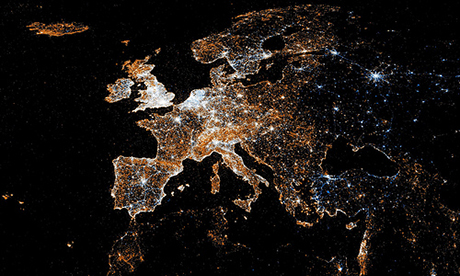
Image: Eric Fischer [CC BY 2.0], via Flickr
The EU is poor at producing the high-quality research that brings technological breakthroughs and economic growth.
The European Commission sees the EU’s mass production of research papers as evidence of a paradox—namely, that Europe is strong in producing knowledge but weak at commercialising it, owing to inefficiencies at the interface between academia and industry. We fundamentally disagree.
Our recent research shows that, far from being a global force in excellent science, Europe trails the United States in the production of highly cited papers and in winning Nobel prizes. European science and industry may or may not be sufficiently linked, but the Commission’s immediate concern should be the health of EU science, not its integration with industry.
Counting published papers as a measure of research strength is like thinking that a football match is won by the team that kicks the ball the most, rather than the one that scores the most goals. The scientific advances that drive hi-tech economic growth are reflections of research quality, not quantity—of highly cited papers, and ultimately of discoveries meriting Nobel prizes. The US produces about twice as many such papers and wins twice as many Nobel prizes as EU nations. This gap has narrowed only slightly in the past 20 years.
We looked at the most highly cited papers—the top 100, 200, 300, 400 and 495—in chemistry, physics, biochemistry and molecular biology, and clinical medicine, published at three-year intervals between 1990 and 2011. The higher one rises through this crème de la crème, the more US-based authors predominate. The lead over the EU, for example, is larger in the top 100 than in the top 495.
The good news is that citations suggest Europe is becoming more competitive in clinical medicine and physics. But this is most likely because these are highly collaborative and international fields, rather than because European science is becoming stronger by itself.
Meanwhile, as the EU inches up the citation scale, China is making sudden and rapid gains, especially in some hot chemistry topics. It is possible that it will eclipse Europe in the coming decades.
The diagnosis, then—that Europe’s hi-tech economy is weak because it struggles to turn excellent science into innovation—is faulty. The problem most likely lies with the science.
Other evidence supports the idea of a link between top-flight science and technological innovation at the national level. In 1997, 73 per cent of the science cited in US industry patents was authored at academic, government and other public institutions. In general every country’s patents over-cite home-grown scientific papers by a factor of two or more.
US patents cited rather basic research, published in influential journals, authored relatively recently at leading research universities and labs, and heavily supported by federal funding agencies. We doubt that the same could be said of European patents.
Europe and the US are equal in the size of their economies and populations. Americans are not inherently smarter than Europeans. So the difference in the two regions’ scientific performance is probably a question of institutions and policy.
Encouraging the mass production of pedestrian papers will certainly not help close the gap. Encouraging risk-taking, and supporting outstanding young researchers tackling new problems, might.
Perhaps Europe is focusing on older, more quiescent areas of research rather than hot topics. China has had success in deploying young and ambitious scientists to topical, economically relevant research areas. For example, 2011’s most highly cited chemistry paper, on polymer solar cells, was authored by scientists at four Chinese institutions. Of the 20 top-cited chemistry papers that year, five had entirely Chinese author lists.
Graphene research shows how Europe has lost the high ground. The number of papers on the material has grown exponentially since 2008. But Europe’s early lead, reflected in the Nobel prize awarded in 2010 to graphene’s two discoverers at the University of Manchester, has vanished. By 2013, the EU’s share of the most cited 100 papers on graphene had sunk to 11 per cent, compared to 43 per cent for the US and 23 per cent for China.
Thus, in both cutting-edge sub-disciplines and across broad fields there is a glaring absence of European science at the top of the distribution of research excellence. If Europe aspires to compete with China and the US in hi-tech industries, then serious analysis and remediation of this weakness seems to be called for.
Francis Narin is the retired president of CHI Research, based in Henderson, Nevada. Alonso Rodríguez-Navarro is a molecular biologist at the Technical University of Madrid. See also Science and Public Policy doi: 10.1093/scipol/scx021 (2017).
More to say? Email comment@ResearchResearch.com
This article also appeared in Research Europe